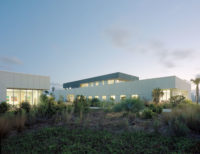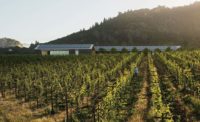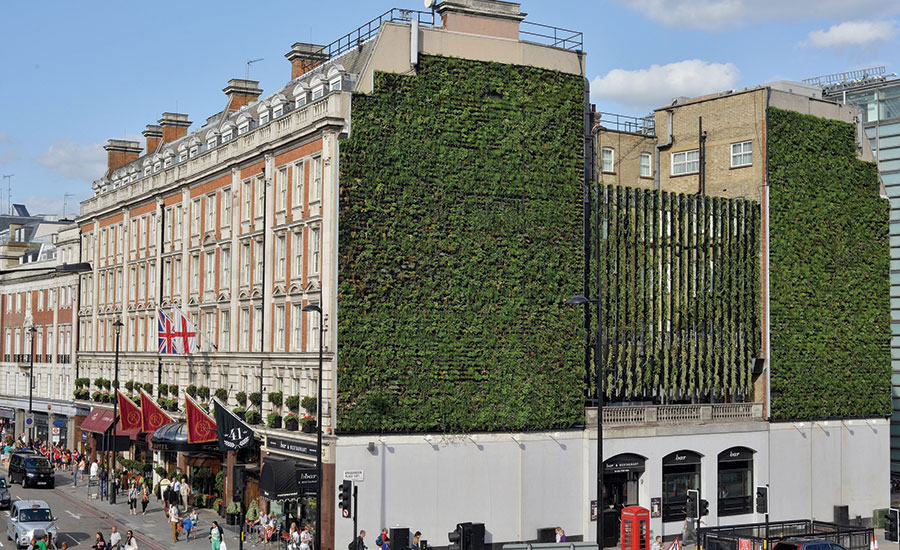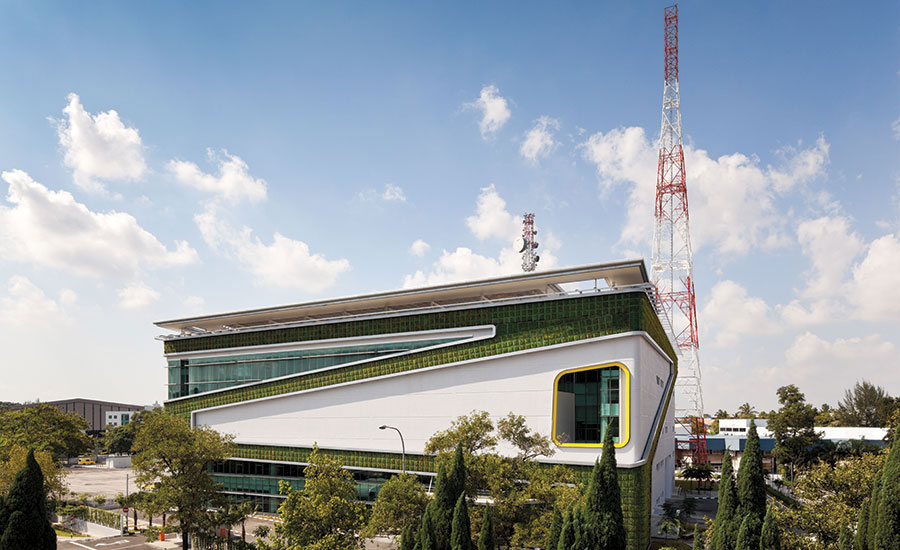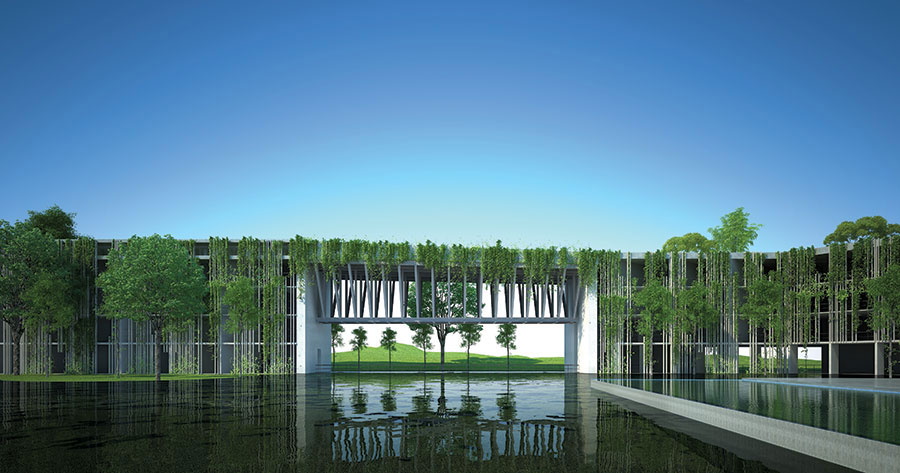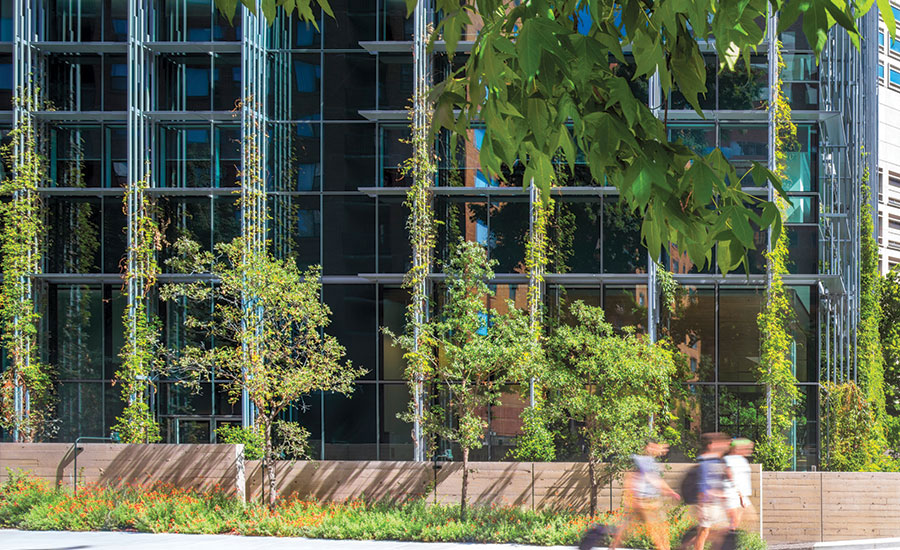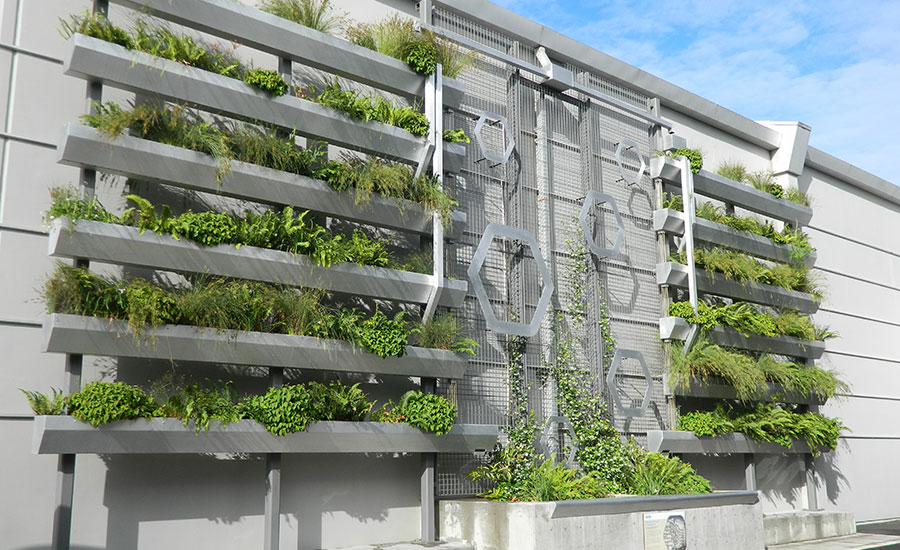Continuing Education: Green Walls

At the Rubens at the Palace hotel, London’s largest living wall flourishes year-round, with 10,000 ferns and herbaceous plants. It is irrigated by runoff from the hotel roof.
Photo courtesy Rubens at the Palace

At the Rubens at the Palace hotel, London’s largest living wall flourishes year-round, with 10,000 ferns and herbaceous plants. It is irrigated by runoff from the hotel roof.
Photo courtesy Rubens at the Palace

Plant selections and continuity of vegetation from the ground up maximize the diversity of birds, butterflies, and other fauna finding refuge and foraging at a data center in Malaysia designed by Ken Yeang for DiGi Telecommunications.
Photo © T.R. Hamzah & Yeang

Vietnamese architect Vo Trong Nghia’s design for the Sheraton Phu Quoc Resort combines an extensive green roof with the “Greenfall” facade of vines and a steel trellis that he used on a 2013 Hanoi house renovation.
Image courtesy Starwood Hotels

Early plans for overhauling Portland’s Edith Green–Wendell Wyatt Federal Building anticipated 200-foot-high vegetated panels shading the western facade. The renovation, designed by Cutler Anderson Architects and SERA Architects and completed in 2013, instead used aluminum rods for shading amid concerns about the proposed living walls’ cost and their viability under wind and strong sun. Vines growing up the facade from ground level retain a green design element.
Photo © Nic Lehoux

Early plans for overhauling Portland’s Edith Green–Wendell Wyatt Federal Building anticipated 200-foot-high vegetated panels shading the western facade. The renovation, designed by Cutler Anderson Architects and SERA Architects and completed in 2013, instead used aluminum rods for shading amid concerns about the proposed living walls’ cost and their viability under wind and strong sun. Vines growing up the facade from ground level retain a green design element.
Photo © Nic Lehoux

Portland-based developer SolTerra employs proprietary living walls as a marketing symbol; 1,100 square feet of vertical vegetation surrounds its LEED Platinum–certified Woodlawn development.
Photo © Sean Airhart

Portland-based developer SolTerra employs proprietary living walls as a marketing symbol; 1,100 square feet of vertical vegetation surrounds its LEED Platinum–certified Woodlawn development.
Photo © Sean Airhart

Roof runoff from Portland’s Expo Center filters through a StormWall designed by GreenWorks consisting of a 30-by-60-foot array of planters.
Photo courtesy City of Portland

The StormWall slows the runoff en route to city drains much like a green roof.
Photo courtesy City of Portland

The first living wall in Genoa, Italy, is being monitored to better understand the cost of green walls, their maintenance requirements, and the potential for energy savings.
Photo courtesy Anna Positano











Facades are a building’s most visible element, and adding plants offers entirely new dimensions of texture, symbolism, and seasonal dynamism. As French botanist and green-wall pioneer Patrick Blanc has said, “A simple wall can become something poetic.” Of course, poems can be tragic, and the risk of failure that comes with vegetating facades has tempered many architects’ enthusiasm. To put it bluntly, green walls can die.
Katia Perini, an instructor at the University of Genoa’s architecture school and an expert in green walls, says the perception of risk has slowed their acceptance. “As architects, we’re not used to having to relate to a growing material. If you use concrete or steel, you know how it will work. In the case of vegetation, everything can change,” says Perini.
A steady uptick in green-wall installations shows that architects are getting past anxiety. Researchers, green-wall providers, and architects say the mainstreaming of planted roofs, marked growth in interior green walls, and accumulated insight from exterior projects to date are all engendering greater comfort with planted facades.
They also see rising awareness of green-wall benefits—from sound and thermal insulation and provision of habitat for bugs and birds to cleaner air and the generalized sense of wellbeing known as biophilia. “The combination of all these benefits is starting to get traction. Green walls are now something that people are taking seriously,” says Gary Grant, a principal with London-based Green Infrastructure Consultancy.
It still takes “the right developer” to push forward a project, says Grant, because green walls are not cheap. But he sees a clear trend toward integration of green walls and says the excitement they offer justifies the expense. “When people want something, they find the money.”
Two Faces of the Green Wall
Engineered green walls take two forms. One type, which academics like Perini refer to as “green facades,” grows climbing vines and ivy on cables or scaffolds, forming a living screen over a built facade. While plants have crawled up walls for millenia, the modern green facade took shape in Berlin in the 1980s and 1990s, where eco-minded incentives spurred the installation of more than 2.5 million square feet of them.
The other green walls—living walls—are dense vertical gardens whose plants seem to burst out of a building’s skin. These consist of preplanted panels or modules affixed to a structural wall or frame, the first of which were developed by Blanc in the 1990s. They gained global fame in 2005 with his 8,600-
square-foot installation at Ateliers Jean Nouvel’s Musée du quai Branly in Paris. Blanc’s plants grow hydroponically within a water-soaked mesh fabric, while competing systems employ lightweight soils (akin to the growth media developed for green roofs) in fabric pockets or trays. All require continuous irrigation and infusions of nutrients and fertilizer.
Living walls’ verdant and varied plantings offer a far more diverse pallet of textures and colors. This design power and biodiversity can be expensive, however. Living walls can reach $125 per square foot, according to Perini. That is three to 10 times the cost of green facades, and she says living walls also require more maintenance.
Grant and other green-wall designers say both types are improving as their creators learn what plants thrive under which conditions. The designers say they are also educating clients better, steering them away from projects facing higher risks of horticulture failure, and preparing them for natural variation.
As Grant puts it, green walls will not always be green. Plants on a southern exposure in London, for example, will die back under summer heat. “They may not look their best all the time. It’s about managing expectations,” says Grant.
Jungle Walls in the Tropics
Green walls are at their greenest and most dramatic in verdant Southeast Asia. Climate helps in locations such as Singapore and Malaysia, where relatively high humidity and narrower temperature swings put less stress on plants and demand less of irrigation systems.
For Malaysian architect and ecologist Ken Yeang, who started planting facades in the 1980s, green walls are first and foremost about engineering ecosystems. Yeang employs flora that supports local fauna, and stresses habitat connectivity to maximize ecosystem value.
Yeang wrapped a vegetated wall around a data center near Kuala Lumpur. The project, completed in 2010 for cellular provider DiGi Telecommunications, includes about 16,000 square feet of plants that angle up from the ground at one corner and zigzag around the structure. Continuous greenery, he says, makes the building an extension of the surrounding habitat. The living wall is also used creatively to improve other building functions. For example, air intakes lie behind the living wall, filtering out particulates and providing what he calls a “small degree” of precooling.
The architect makes no apologies for the pruning, replacement of dead plants, and other maintenance required. “I tell the owners that it’s like having your own garden, where you must cut the grass and look after the flowers. They must be committed to looking after the garden,” he says.
More recent projects in Southeast Asia blend planted facades, terraces, and roofs to literally drape structures in greenery. In contrast to DiGi, where a band of living wall visually complements the otherwise rectilinear facade, for these projects the organic-inorganic frontier almost disappears.
Twin skyscrapers under construction in Kuala Lumpur, another of the many collaborations between Nouvel and Blanc, will be splashed with growing greens and reds across most of their 49 and 43 stories. Video released by Hong Kong–based developer Wing Tai shows living walls at the penthouse levels, while flowering plants climb stainless-steel cables to adorn the bulk of the towers’ steel-and-glass facades. One newspaper described the effect as “jungle-themed.”
Jungle certainly evokes the work of Singapore-based WOHA whose buildings seem enveloped in greenery, as well as recent projects by Vietnamese architect Vo Trong Nghia. Take the Sheraton Phu Quoc Resort designed by Nghia’s Ho Chi Minh City–based firm for Starwood Hotels, scheduled to open in July 2017. In some renderings, the nearly 380,000-square-foot structure nearly disappears into its wooded surroundings under a continuous coating of vegetation.
Vertical Green in Portland
Making green walls practical at higher latitudes is a taller order. Larger seasonal shifts and extreme weather stress plants, and they test the irrigation systems required to sustain living walls. One region showing progress even so is the Pacific Northwest.
Despite their reputation for moderate climates, cities like Seattle and Portland freeze in winter and their summers can be bone dry. “We’ve gone 90 to 110 days without rain in recent summers,” notes Brian Heather, president at SolTerra, a Portland-based design-build developer with a penchant for living walls.
Heather says that SolTerra has gained a great deal of knowledge since creating a proprietary living-wall system in 2009, especially about irrigating big walls. Irrigation systems must automatically drain during cold snaps to protect water lines from bursting, and they must anticipate gravity and wind to distribute water evenly. “You can end up with a lot more water at the bottom of the wall than at the top,” he says.
In 2010, concerns about irrigation helped torpedo 200-foot-high green walls proposed for the extensive overhaul of the 1970s-era Edith Green–Wendell Wyatt Federal Building in Portland. Initial plans called for vertical fins adorned with plants to shade the 18-story office tower’s western facade from intense midday sun and heat. But doubts about the viability and cost of maintaining living walls in that harsh environment killed the original green-wall plan.
Cutler Anderson Architects and SERA Architects, who designed the renovation, ultimately used aluminum rods to shade the facade. But they retained a vegetated fringe at the bottom by sending vines up the rods from ground-level planters. The climbers have thrived since the project’s 2013 completion and add “a lot of visual interest,” according to Amy Chomowicz, an urban planner in Portland’s Bureau of Environmental Services. “The vines must be at least 30 feet high,” she says.
SolTerra, meanwhile, is now scaling up its own living walls after “years of trial and error,” says Heather. They feature in SolTerra’s first completed development and in almost all of the 12 more under construction or at the permitting or design stage. Its 18-unit Woodlawn development in Portland, an apartment building with ground-level commercial space completed last year, teems with 3,500 plants covering most of its vertical surfaces that aren’t glazed.
Green walls head skyward in the next SolTerra projects, including an office project under construction in Portland, Oregon. It will feature a 70-foot-high, 40-foot-wide living wall mural. Heather says green walls project the ecology and wellness-oriented marketing strategy behind SolTerra’s LEED Platinum developments. With rental revenue running 40 percent higher than projected, he says the walls are worth the cost: “There’s a huge amount of payback for our company from incorporating sustainable features, and the living walls in particular.”
Green Infrastructure
Green walls may ultimately follow the trajectory of green-roof adoption, combating a broad array of urban ills such as flooding, overheating, and air pollution. Grant, from the Green Infrastructure Consultancy, took an early stab at putting walls to work against stormwater surges in a 2013 installation at London’s Rubens at the Palace hotel.
Greening the roof was not an option, structurally, for the century-old building, so Grant designed a 38,000-square-foot living wall—London’s largest—to turn the Rubens’s previously unadorned brick face into a living sponge. Two 2,600-gallon cisterns buffer the runoff, then pump it to the wall’s ferns and herbaceous plants.
Planner Chomowitz, who champions green roofs, spearheaded a more direct stormwater wall at the Portland EXPO Center in Oregon. The city commissioned local landscape architect GreenWorks to fashion custom planters, arrayed across the EXPO’s north wall, to filter runoff from its 9,400-square-foot roof.
Completed in 2014, the living wall’s 20-foot-long planters overflow with ferns, salal, and other rain forest natives. A pair of mallards took up residence this spring. Irrigation sustains the rain forest scene through the summer, evoking the flora of the nearby Columbia Gorge.
Mike Faha, GreenWorks’ founding principal, says the StormWall employs the same media typically used to soak up water on large green roofs planted with desert sedums and bunch grasses. But here the growth media is four to five times deeper, maximizing water retention.
Tim Kurtz, a city engineer tracking the StormWall, estimates that it reduces peak flows by 50 to 70 percent during big storms. “It’s definitely having an impact,” says Kurtz. If implemented at a large scale, he says, such walls could reduce the number of times rainfall overwhelms sewers and wastewater treatment plants.
Green walls can also treat the urban heat island (UHI) effect whereby solar radiation absorbed by roads and buildings makes cities hotter than surrounding rural areas. UHI is not just a future threat associated with climate change. In Melbourne, where UHI effects increase air temperature as much as 7 degrees Centigrade, a 2009 heat wave caused a 62 percent spike in human mortality.
Vegetating surfaces provides shade and also cools through transpiration of water vapor. Researchers at Australia’s University of Melbourne and Monash University identified important roles for green walls in a recent review of strategies for mitigating UHI. Economical green facades, they write, could cool large swaths of the city where limited open space precludes tree planting.
Trees can block ventilation and become counterproductive in tight city spaces. According to the Australian review, living walls—which cost more but will probably deliver more cooling—could target these hot spots.
Mainstream Green
Green walls are beginning to get credit for their ecological and societal benefits under development codes that increasingly mandate green screening. SolTerra is taking advantage of Seattle’s Green Factor landscaping mandates, which award developers extra points for green walls to encourage innovation.
However, researchers say better quantification of green wall benefits is needed to underpin incentives such as Seattle’s and spur investment by developers. While green roofs have proven their ability to pay for themselves through energy savings, stormwater mitigation, and extended roof lifetime, a dearth of data on green walls means they remain largely driven by aesthetic whim.
Perini took an early stab at a cost-benefit study in 2013, modeling south-facing green facades and living walls for a fictional four-story Genoa office building. Using data drawn from the academic literature, she estimated property value appreciation and energy savings worth a combined $4,200 per year for a living wall and about $2,300 per year for a green facade. The green facade paid for itself. The living wall, with its higher installation and maintenance costs, did not.
However, she says the study was deliberately conservative, since it relied on other researchers’ data. To get better data, Perini and her colleagues built Genoa’s first living wall and have been studying it since the end of 2014. She has yet to disclose the wall’s performance, but hints that their data put living walls in a better light. “We do hope to demonstrate that living walls can be economically sustainable,” says Perini.
Some of the less tangible benefits of green walls, such as biophilia, may be hard to quantify, but their value is easily observed. SolTerra’s Heather recounts watching a couple with a young child outside the Woodlawn development, pointing up to a bird nesting in the living facade. “It adds to the neighborhood,” he says. “It is something that people are much more proud of than a traditional building.”
|
Continuing Education

To earn one AIA learning unit (LU), including one hour of health, safety, and welfare (HSW) credit, read “The Cultivated Facade,” review the supplemental material listed below, and complete the online test. Upon passing the test, you will receive a certificate of completion, and your credit will be automatically reported to the AIA. Additional information regarding credit-reporting and continuing-education requirements can be found online at continuingeducation.bnpmedia.com.
Supplemental Material Cities Alive: Rethinking Green Infrastructure (Executive Summary, pages 5 through 14), Arup
Learning Objectives 1 Outline the ecological benefits of green walls and other types of green infrastructure. 2 Discuss the social, biophilic, and aesthetic benefits of green walls. 3 Describe the different types of green walls, explain how each type is installed, and characterize their maintenance requirements. 4 Summarize available data regarding the cost of green walls relative to potential property value appreciation and savings from energy conservation, storm-water retention, and other performance enhancements green wall can provide.
AIA/CES Course #K1607A
For CEU credit, read "The Cultivated Facade" and take the quiz at continuingeducation.bnpmedia.com, or use our architectural record continuing-education app, available in the itunes store.
structure, finishes, and other original fabric when
a building is moved.
significant buildings.
|

